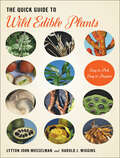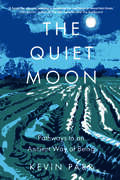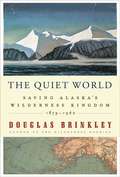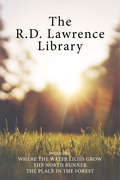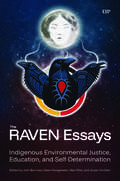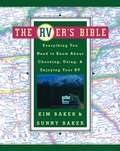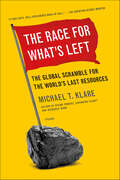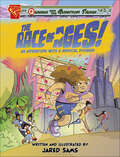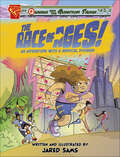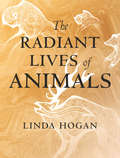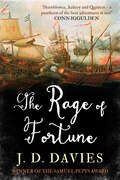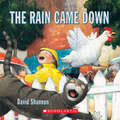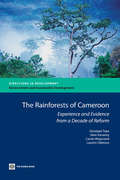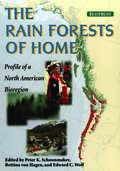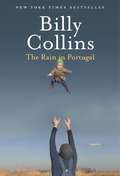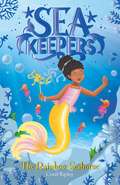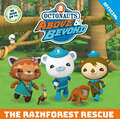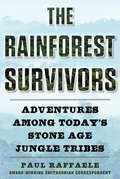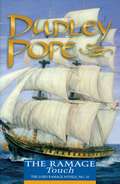- Table View
- List View
The Quick Guide to Wild Edible Plants: Easy to Pick, Easy to Prepare
by Lytton John Musselman Harold J. WigginsField-to-table cuisine! Connect with (and eat) the diverse flora around us.A recent rise in the popularity of urban farming, farmers’ markets, and foraging from nature means more people are looking for information about plants. In The Quick Guide to Wild Edible Plants, botanists Lytton John Musselman and Harold J. Wiggins coach you on how to safely identify, gather, and prepare delicious dishes from readily available plants—and clearly indicate which ones to avoid.More than 200 color illustrations, accompanied by detailed descriptions, will help you recognize edible plants such as nettles, daylilies, river oats, and tearthumbs. For decades, Musselman and Wiggins have taught courses on how to prepare local plants, and their field-to-table recipes require only a few, easily found ingredients. They offer instructions for making garlic powder out of field garlic and turning acorns into flour for Rappahannock Acorn Cakes. To toast your new skill, they even include recipes for cordials. The Quick Guide to Wild Edible Plants is a great gift for the beginning naturalist and the perfect addition to every serious forager’s library.
The Quiet Moon: Pathways to an Ancient Way of Being
by Kevin ParrThe ancient Celts lived by and worshipped the moon. While modern, digital life is often at odds with nature – rubbing against it rather than working in harmony with it – is there something to be said for embracing this ancient way of being and reconnecting to the moon’s natural calendar?*January’s Quiet Moon reflects an air of melancholy, illuminating a midwinter of quiet menace; it was the time of the Dark Days for the ancient Celts, when the natural world balanced on a knife edge. By May, the Bright Moon brings happiness as time slows, mayflies cloud and elderflowers cascade. Nature approaches her peak during a summer of short nights and bright days – this was when the ancient Celts claimed their wives and celebrated Lugnasad. With the descent into winter comes the sadness of December’s Cold Moon. Trees stand bare and creatures shiver their way to shelter as the Dark Days creep in once more and the cycle restarts.In The Quiet Moon, Kevin Parr discovers that a year of moons has much to teach us about how to live in the world that surrounds us – and how being more in tune to the rhythms of nature, even in the cold and dark, can help ease the suffering mind.
The Quiet World: Saving Alaska's Wilderness Kingdom, 1879-1960
by Douglas BrinkleyA riveting history of America's most beautiful natural resources, The Quiet World documents the heroic fight waged by the U.S. federal government from 1879 to 1960 to save wild Alaska--Mount McKinley, the Tongass and Chugach national forests, Gates of the Arctic, Glacier Bay, Lake Clark, and the Coastal Plain of the Beaufort Sea, among other treasured landscapes--from the extraction industries. Award-winning historian Douglas Brinkley traces the wilderness movement in Alaska, from John Muir to Theodore Roosevelt to Aldo Leopold to Dwight D. Eisenhower, with narrative verve. Basing his research on extensive new archival material, Brinkley shows how a colorful band of determined environmentalists created the Arctic National Wildlife Refuge just before John F. Kennedy became president. Brinkley introduces a lively gallery of characters influential in preserving Alaska's wilderness resources: the indomitable U.S. Supreme Court justice William O. Douglas, who championed the Brooks Range; charming Ivy League explorer Charles Sheldon, who led the campaign to create Denali National Park; intrepid Bob Marshall, who cofounded The Wilderness Society; hermit illustrator Rockwell Kent, who lived in isolation on Fox Island like a modern Thoreau; nature photographer Ansel Adams, whose image Mount McKinley and Wonder Lake set off a tsunami of public interest in America's tallest peak; and U.S. Fish and Wildlife biologist Rachel Carson, who promoted proper ocean stewardship; among many more. Wildlife fervently comes to life in The Quiet World: Brinkley tells incredible stories about the sea otters in the Aleutians, moose in the Kenai Peninsula, and bird life across the Yukon Delta expanse while exploring the devastating effects that reckless overfishing, seal slaughter, and aerial wolf hunting have wrought on Alaska's once-abundant fauna. While taking into account Exxon Valdez-like oil spills, The Quiet World mainly celebrates how the U.S. government has preserved many of Alaska's great wonders for future generations to enjoy.
The Quilter's Practical Guide to Color: Includes 10 Skill-Building Projects
by Becky GoldsmithLearn how to make choosing colors fun! Did you know that the biggest struggle for quilters of all types is color selection? Unlock the secrets to winning color combinations from best-selling author Becky Goldsmith of Piece O’ Cake Designs. Learn how every quilt has a foreground and a background, how to use clear versus gray colors—plus other essentials that will shake up your design process. Quilters of all skill levels will appreciate Becky’s practical, easy-to-understand advice on neutrals, value, and contrast. Put your newfound knowledge to the test with 10 pieced and appliquéd projects designed to focus on specific aspects of color. With visual examples used to explain all color topics, this go-to guide will give you an edge when it comes to quilt design. Practical, visual guide to color written specifically for quilters 10 pieced and appliquéd projects to apply your color knowledge Take the fear out of fabric selection with important, rarely discussed concepts Best-selling author Becky Goldsmith of Piece O’ Cake Designs
The Quilting Manual
by C&T PublishingNext-level quilting designs to boost your creativity Conquer those unfinished quilt tops with inspiring designs and essential techniques for both hand and machine quilters. Whether you're an advanced beginner or more experienced, this robust variety of 100+ free-motion and walking-foot designs will make planning your quilting exciting again. Gain proficiency and get inspired with this all-in-one guide to quilting techniques and motifs from 16 esteemed quilters, including Alex Anderson, Natalia Bonner, Christina Cameli, Laura Lee Fritz, Geta Grama, Jenny Carr Kinney, Don Linn, Cheryl Malkowski, Christine Maraccini, Gina Perkes, Sylvia Pippen, Kathy Sandbach, Jessica Schick, Sheila Sinclair Snyder, Hari Walner, and Angela Walters. • Energize your quilting with 100+ gorgeous continuous and stand-alone designs for blocks, borders, and more • Move beyond the basics! Sixteen quilting all-stars share skill-building techniques and rich, lustrous motifs • Finish quilts with the feed dogs up or down—troubleshooting tips for hand, machine, and longarm quilters
The R.D. Lawrence Library: Where the Water Lilies Grow / The North Runner / The Place in the Forest
by R. D. Lawrence Max FinkelsteinThis special 3-book bundle collects three of the works of master nature writer R.D. Lawrence. In The North Runner, he tells the true and moving story of the building of trust between a man and an exceptional dog that was half wolf, half Alaskan Malamute, and the resulting mutual affection and respect between them. In The Place in the Forest, he tells of a patch of Ontario wilderness, soon known as "The Place." Here Lawrence and his wife built a cabin and became immersed in studying the ways of the wild. "The Place" was home to a variety of wildlife, from black bears, wolves, beavers and raccoons through to hawks, snapping turtles and singing mice. Lawrence’s desire to learn, fuelled by his keen observation, led to his writing about and photographing life within his small corner of the forest — the result being a warm, witty account of change and survival in the natural world. The sequel, Where the Water Lilies Grow, continues the story of animals who inhabit the lakeside near his backwoods home. From the smallest water creature to wolves, deer and many, many birds, all are known to him with sensitivity, enthusiasm and empathy. Includes The North Runner The Place in the Forest Where the Water Lilies Grow
The RAVEN Essays: Indigenous Environmental Justice, Education, and Self-Determination
by John Borrows Susan Smitten Max Ritts Dawn HoogeveenNamed after the Respecting Aboriginal Values and Environmental Needs (RAVEN) nonprofit organization, The RAVEN Essays is an anthology that celebrates a decade of prize-winning student essays. Since 2012, RAVEN has awarded an annual essay prize to honour students who champion the vital importance of Indigenous rights and self-determination, both in Canada and globally. The essays featured in this collection highlight exceptional student work while reflecting on the evolving relationship between Indigenous politics and academia. From issues like fishing rights and the Trans Mountain Pipeline to challenges of sexism and conservation policy, these essays capture a transformative period in Indigenous struggles, offering insights that resonate far beyond the Canadian settler state.The anthology also includes contributions from prominent scholars such as Glen Coulthard, Dara Culhane, Michael Fabris, Sarah Hunt, and Heather Dorries. Five complementary essays explore various aspects of structural change, institutional constraints, and broader commitments to Indigenous knowledge within university settings. Aimed at readers in Indigenous law, environmental studies, anthropology, and geography, The RAVEN Essays is a book created by students for students, and by academics for the academy. Together, the contributors reflect on the powerful formation and enactment of Indigenous law, environmental stewardship, place-based knowledge, pedagogy, and literacy – both within the academy and in the broader community, across land, water, and culture.
The RVer's Bible (Revised and Updated): Everything You Need to Know About Choosing, Using, and Enjoying Your RV
by Kim Baker Sunny BakerThe Rver's Bible is the ultimate guide to living and traveling in a recreational vehicle. From purchasing, maintaining, and driving the rig to navigating the emotional pitfalls of life on the road, this handbook covers all the bases. Now revised and updated, the RVer's Bible keeps you up-to-date with all the new technologies and systems of the 21st century RV.
The Race for What's Left: The Global Scramble for the World's Last Resources
by Michael T. KlareFrom Michael Klare, the renowned expert on natural resource issues, an invaluable account of a new and dangerous global competitionThe world is facing an unprecedented crisis of resource depletion—a crisis that goes beyond "peak oil" to encompass shortages of coal and uranium, copper and lithium, water and arable land. With all of the planet's easily accessible resource deposits rapidly approaching exhaustion, the desperate hunt for supplies has become a frenzy of extreme exploration, as governments and corporations rush to stake their claim in areas previously considered too dangerous and remote. The Race for What's Left takes us from the Arctic to war zones to deep ocean floors, from a Russian submarine planting the country's flag on the North Pole seabed to the large-scale buying up of African farmland by Saudi Arabia, China, and other food-importing nations.As Klare explains, this invasion of the final frontiers carries grave consequences. With resource extraction growing more complex, the environmental risks are becoming increasingly severe; the Deepwater Horizon disaster is only a preview of the dangers to come. At the same time, the intense search for dwindling supplies is igniting new border disputes, raising the likelihood of military confrontation. Inevitably, if the scouring of the globe continues on its present path, many key resources that modern industry relies upon will disappear completely. The only way out, Klare argues, is to alter our consumption patterns altogether—a crucial task that will be the greatest challenge of the coming century.
The Race of Ages!: An Adventure with a Medical Pioneer
by Jared SamsRosa is challenged to a footrace by augmented athletes from the future. She's up for the test—but is her recently repaired heart? With the help of Dr. Domingo Liotta, the inventor of the first artificial heart, Qianna will do everything she can to help her friend cross the finish line first. But will her efforts be enough? Find out in a dynamic graphic novel that gives science, engineering, and invention a hip-hop spin!
The Race of Ages!: An Adventure with a Medical Pioneer
by Jared SamsRosa is challenged to a footrace by augmented athletes from the future. She's up for the test—but is her recently repaired heart? With the help of Dr. Domingo Liotta, the inventor of the first artificial heart, Qianna will do everything she can to help her friend cross the finish line first. But will her efforts be enough? Find out in a dynamic graphic novel that gives science, engineering, and invention a hip-hop spin!
The Radiant Lives of Animals
by Linda HoganFrom a celebrated Chickasaw writer, a spiritual meditation, in prose and poetry, on our relationship to the animal world, in an illustrated gift package.Concerned that human lives and the natural world are too often defined by people who are separated from the land and its inhabitants, Indigenous writer and environmentalist Linda Hogan depicts her own intense relationships with animals as an example we all can follow to heal our souls and reconnect with the spirit of the world. From her modest forest home in Colorado, and venturing throughout the region, especially to her beloved Oklahoma, she introduces us to horses, packrats, snakes, mountain lions, elks, wolves, bees, and so many others whose presence has changed her life. In this illuminating collection of essays and poems, lightly sprinkled with elegant drawings, Hogan draws on many Native nations' ancient stories and spiritual traditions to show us that the soul exists in those delicate places where the natural world extends into human consciousness--in the mist of morning, the grass that grew a little through the night, the first warmth of this morning's sunlight. Altogether, this beautifully packaged gift is a reverential reminder for all of us to witness and appreciate the radiant lives of animals.
The Radioactive Boy Scout: The Frightening True Story of a Whiz Kid and His Homemade Nuclear Reactor
by Ken SilversteinThrowing caution to the wind, David Hahn plunged into a new project: building a model nuclear reactor in his backyard garden shed. Posing as a physics professor, David solicited information on reactor design from the U.S. government and from industry experts. Following blueprints he found in an outdated physics textbook, David cobbled together a crude device that threw off toxic levels of radiation. His wholly unsupervised project finally sparked an environmental emergency that put his town's forty thousand suburbanites at risk. The EPA ended up burying his lab at a radioactive dump site in Utah. This offbeat account of ambition and, ultimately, hubris has the narrative energy of a first-rate thriller.
The Rage of Fortune (The Matthew Quinton Journals)
by J. D. DaviesThis prequel to the &“excellent&” Matthew Quinton Journals series reveals the legacy of the Royal Navy captain (Publishers Weekly). In 1651, eleven-year-old Matthew Quinton and his twin sister Henrietta discover long-forgotten papers of their grandfather. Dating back to 1598, they show the children an England locked into a bitter war with Spain. But their findings are interrupted by the arrival of Roundhead troops intent on searching for their elder brother, the tenth Earl of Ravensden, who has been seriously wounded in the Cavalier cause. Back in the present of 1651, England&’s enemies are closer to home, with the country gripped by civil war. Now the Roundheads are closing in . . . Set against the backdrop of real historical events The Rage of Fortune is a window into Mathew Quinton&’s origins. Praise for the writing of J. D. Davies: &“Hornblower, Aubrey and Quinton—a pantheon of the best adventures at sea!&” —Conn Iggulden, #1 New York Times–bestselling author of The Conqueror and War of the Roses series &“A hero worth rooting for.&” —Publishers Weekly &“Utterly impossible to put down . . . Finely-shaded characters, excellent plotting, gut-clenching action and immaculate attention to period detail . . . Superb.&” —Angus Donald, author of The Outlaw Chronicles series &“Destined to be a classic of nautical adventure series.&” —Eric Jay Dolin, author of Leviathan and Fur, Fortune, and Empire &“A naval adventure that goes well beyond the usual outlines of the genre to paint a lively portrait of England in the 1600s.&” —Kirkus Reviews
The Rain Came Down
by David ShannonCaldecott Honor artist David Shannon captures the chaos that follows an unexpected downpour in this engaging story.Once upon a sunny day, the sky clouded over, and the rain came down. The chickens squawked, the dog barked, the baby cried, the traffic snarled, the groceries fell, the people bickered, and still, the rain came down.In pictures full of wit and good-natured humor, Caldecott Honor artist David Shannon captures the chaos that follows an unexpected downpour.Rain or shine, here is an engaging story that will brighten the day of any reader.
The Rain Forests of Cameroon: Experience and Evidence from a Decade of Reform
by Carole Megevand Giuseppe Topa Laurent Debroux Alain KarsentyStarting in 1994, Cameroon introduced regulatory and market-based reforms to regulate access to its rainforests, balance public and private interests in those forests, and integrate wider economic, cultural, and environmental perspectives of the value of forests. Based on historical data and extensive interviews, this report concludes that the reforms brought order over the most aggressively competing interests and started to address deeper social and environmental issues, but a significant unfinished agenda remains. On the positive side, information on the boundaries, ownership, use rights, and management of Cameroon's rainforests has become available for public scrutiny, along with information on detection and prosecution of illegal activities. Better and better known rules of the game have improved forest governance and collaboration between forest institutions and civil society. More than 60 percent of Cameroon's rainforests are under management systems that emphasize sustainability. Illegal logging has declined sharply managed parks and production forests, although it persists in rural areas. The restructured forest industry has adopted internationally recognized management practices that have started to align logging with the forest's capacity to regenerate. Cameroon has established rules to preserve customary rights to forests, and community forests have progressed despite unanticipated challenges. Yet further reform is needed. Deeper recognition of the customary rights of all people who depend on Cameroon's forests, regardless of ethnicity, is vital. Timber and nontimber forest products like medicinal plants and bush meat remain subject to illegal exploitation outside state forests. Cameroon needs qualified eco-investors to sustain conservation and diminish reliance on timber production. Community involvement in the management of all types of forests should expand further. Great attention to local markets and small firms will strengthen forest governance and the forest industry in important ways. Rewarding responsible corporate behavior with more lenient bank guarantees and tax incentives may prove as important for conserving forests as punishing corporate misbehavior.
The Rain Forests of Home: Profile Of A North American Bioregion
by Jerry F. Franklin Patricia Marchak Peter Schoonmaker Edward C. Wolf Bettina Von HagenStretching from the redwoods of California to the vast stands of spruce and hemlock in southeast Alaska, coastal temperate rain forests have been home to one of the highest densities of human settlements on the continent for thousands of years. However, the well-being of this region is increasingly threatened by diminishing natural capital, declining employment in traditional resource-based industries, and outward migration of young people to cities.The Rain Forests of Home brings together a diverse array of thinkers -- conservationists, community organizers, botanists, anthropologists, zoologists, Native Americans, ecologists, and others -- to present a multilayered, multidimensional portrait of the coastal temperate rain forest and its people. Joining natural and social science perspectives, the book provides readers with a valuable understanding of the region's natural and human history, along with a vision of its future and strategies for realizing that vision.Authors describe the physical setting and examine the geographic and evolutionary forces that have shaped the region since the last glacial period, with individual chapters covering oceanography, climate, geologic processes, vegetation, fauna, streams and rivers, and terrestrial/marine interactions. Three chapters cover the history of human habitation, and the book concludes with an exploration of recent economic, political, and cultural trends.Interspersed among the chapters are compelling profiles of community-level initiatives and programs aimed at restoring damaged ecosystems, promoting sustainable use of resources, and fostering community-based economic development. The Rain Forests of Home offers for the first time a unified description of the characteristics, history, culture, economy, and ecology of the coastal temperate rain forest. It is essential reading for anyone who lives in or cares about the region.
The Rain in Portugal: Poems
by Billy CollinsFrom former U.S. Poet Laureate Billy Collins comes a twelfth collection of poetry offering nearly fifty new poems that showcase the generosity, wit, and imaginative play that prompted The Wall Street Journal to call him "America's favorite poet." The Rain in Portugal--a title that admits he's not much of a rhymer--sheds Collins's ironic light on such subjects as travel and art, cats and dogs, loneliness and love, beauty and death. His tones range from the whimsical--"the dogs of Minneapolis . . . / have no idea they're in Minneapolis"--to the elegiac in a reaction to the death of Seamus Heaney. A student of the everyday, here Collins contemplates a weather vane, a still life painting, the calendar, and a child lost at a beach. His imaginative fabrications have Shakespeare flying comfortably in first class and Keith Richards supporting the globe on his head. By turns entertaining, engaging, and enlightening, The Rain in Portugal amounts to another chorus of poems from one of the most respected and familiar voices in the world of American poetry. On Rhyme It's possible that a stitch in time might save as many as twelve or as few as three, and I have no trouble remembering that September has thirty days. So do June, November, and April. I like a cat wearing a chapeau or a trilby, Little Jack Horner sitting on a sofa, old men who are not from Nantucket, and how life can seem almost unreal when you are gently rowing a boat down a stream. That's why instead of recalling today that it mostly pours in Spain, I am going to picture the rain in Portugal, how it falls on the hillside vineyards, on the surface of the deep harbors where fishing boats are swaying, and in the narrow alleys of the cities where three boys in tee shirts are kicking a soccer ball in the rain, ignoring the window-cries of their mothers.
The Rain in the Woods (Fountas & Pinnell Classroom, Guided Reading)
by Amber FitchNIMAC-sourced textbook. All Wet. See what you can find in the rain.
The Rainbow Seahorse: Book 7 (Sea Keepers #7)
by Coral RipleyGet ready to dance the night away! The Sea Keepers are invited to a masked ball in this magical story about saving our oceans. Emily, Grace and Layla are invited to the annual masked ball in an ancient sunken city where the seahorses perform a special dance. But when evil Effluvia sneaks into the party in disguise, she uses her bad magic to destroy the beautiful ruins. The Sea Keepers need to find a magic pearl to save the city. Can true love defeat evil in this exciting underwater adventure?
The Raindrop Spell: Book 1 (Fairy Forest School #1)
by Olivia BrookA brand-new fairy school series about helping animals and looking after nature, from the home of Rainbow Magic!Poppy Merrymoss is so excited to start at Oakwings Academy, a beautiful fairy school in the trunk of an old oak tree. There she'll learn about all the different types of magic that fairies use to help nature, and she'll discover what type of fairy she'll be when she grows up! But when evil Lady Nightshade puts a curse on the forest, stopping the adult fairies from making the magic seeds that create fairy dust, it's up to Poppy and her friends to save the forest! Can Poppy and her friends Ninad Cleardrop and Rose Seedpip stop Lady Nightshade and rescue a little lost otter?Look out for Poppy Merrymoss's next adventure, Fairy Forest School: Baby Bunny Magic.
The Rainforest Book (Conservation for Kids)
by Charlotte MilnerEmbark on a journey through the magical world of the rainforest and introduce little nature-lovers to an enchanting, yet threatened, tropical worldStep inside the fascinating world of tropical rainforests where you&’ll encounter an enormous variety of flora and fauna! This gorgeously illustrated picture book is a wonderful way to introduce kids to the world of nature and conservation.The rainforests are bursting with life! Sweep aside the liana vines, hop over the giant roots of the kapok tree, and discover magnificent tigers roaming the jungle. In this enchanting children&’s book, you&’ll discover amazing rainforest animals, learn about the diverse range of life-giving plants, and find out why the Amazon rainforest is known as the &“lungs&” of our Earth. This colorful children&’s book captures the spirit of the rainforest through its beautifully detailed illustrations by Charlotte Milner. It has simple, clear text that is accessible to less confident readers but a strong message about deforestation and climate change will captivate older readers too.Let&’s Explore!Venture into the depths of the tropical rainforest and uncover riveting facts about these marvels of nature. Did you know that the air in a rainforest feels wet because trees and plants release water that they don&’t need into the air? And that over half of our planet&’s wildlife live in the rainforest? The world&’s rainforests are packed with amazing creatures! From the nocturnal kinkajou to the stinky rafflesia flower – there is plenty to discover in this plant and animal encyclopedia. Perfect for kids aged 5-9 years, it also includes a fun gardening activity section with instructions on how to grow your own miniature rainforest at home.Complete the Series:Following on from The Bee Book, The Sea Book, and The Bat Book, these engaging plant and animal books highlight the important ecological issues faced by our planet. It&’s perfect for parents who want to encourage children to learn about ecology and remind them that it is up to us to care for our planet.
The Rainforest Rescue (Octonauts Above & Beyond #2)
by Official OctonautsThe Octonauts return with a new global mission - on land! Enlisting their intrepid friends from around the world as Octo-agents - and equipped with a new fleet of land-based Terra Gups - the Octonauts' work is as vital as ever. They will explore far-flung environments, rescue animals that need their help and protect the land and all living creatures.Featuring everyone's favourites from the original series, such as Captain Barnacles and Kwazii Cat, OCTONAUTS: ABOVE AND BEYOND also introduces lovable new characters like Paani, the water scientist monkey - not to mention their cool new vehicle, the Octo-Ray! Together the crew embark on exciting missions to save animals everywhere who need their help.Each book includes a fact file about some of the amazing creatures featured in the story. Look out for book 2 in October 2023.
The Rainforest Survivors: Adventures Among Today's Stone Age Jungle Tribes
by Paul RaffaeleEven in our hyper-connected world, there are tribes scattered across the far reaches of the globe who still live much the same way that their ancestors did thousands of years ago. Having had minimal contact with the outside world, these peoples currently live in harmony and unison with the environment around them. But as technology grows and the human population expands, the way of life of these tribes becomes increasingly threatened with every passing day. In The Rainforest Survivors, veteran overseas reporter Paul Raffaele recounts his time spent with three unique jungle tribes—the peace-loving Congo Pygmies, New Guinea’s tree-dwelling Korowai cannibals, and the Amazon’s ferocious Korubo. Over months spent living in these three communities, Raffaele experienced firsthand wisdom and mysterious rites forged over many millennia. Resonating with high adventure and remarkable characters, The Rainforest Survivors details the daily lives of these relatively unknown peoples and provides key political and environmental context, showing how outside forces are closing in on them and threatening to change forever their ways of life. Enthralling and unforgettable, this compelling book is the important portrait of indigenous peoples living the way they have for centuries.
The Ramage Touch
by Dudley PopePost Captain Ramage is prowling the Tuscan coast and far from English aid when he encounters a daunting French invasion fleet. As the enemy gathers strength, Ramage must decide how to thwart its actions with only the frigate Calypso and a pair of bomb ketches.
